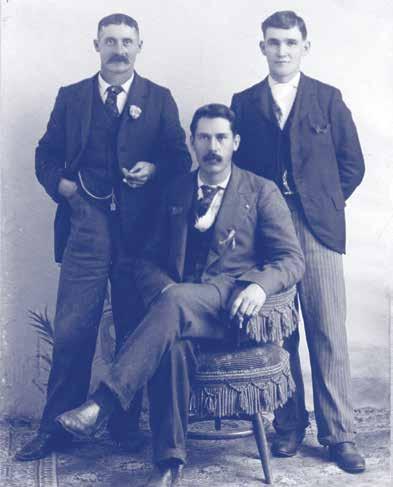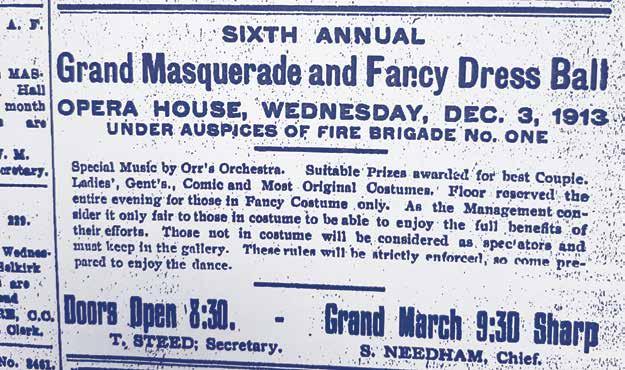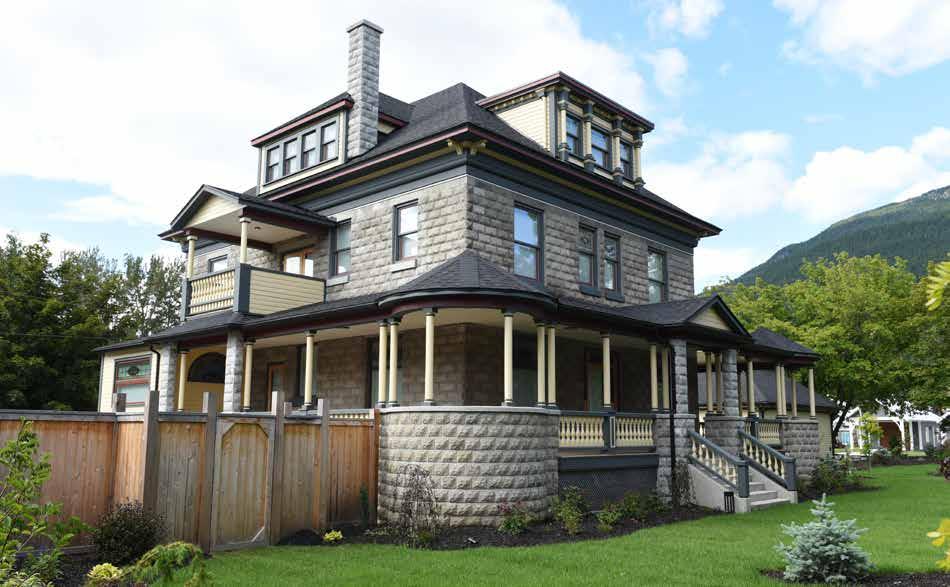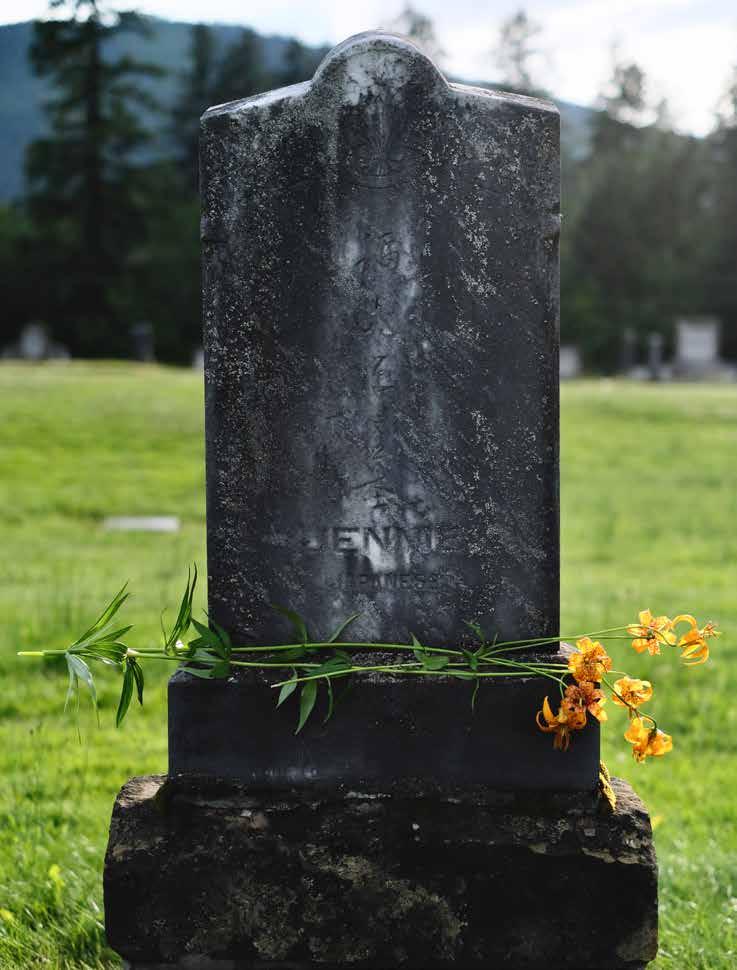
37 minute read
Masquerades unmasked. p
Guy Barber appears in many photographs in the Revelstoke Museum & Archives. Many of them are sports pictures, such as the 1891 ski club and the 1909 curling club and the snowshoe club; others show Guy in front of his jewellery store. He also appears in several photographs of local entertainment, such as the 1911 Fireman’s Masquerade Ball. Image courtesy of Revelstoke Museum & Archives
Guy is unmissable in a Who’s Who of Revelstoke’s early days. Image courtesy of Revelstoke Museum & Archives
MASQUERADES UNMASKED
WRITER’S NOTE: The following is a true(ish) story based on an assortment of newspapers articles, obituaries, and biographies It is not in any way a definitive historical account as I make many assumptions.
Part I: Unmasked
“The scene was one of fascination, the effect being heightened by the fact that few of the dancers could be recognized behind their masks … Soldiers mingled with oriental beauties, coy peasant girls made eyes at dashing cavaliers and cowboys, while clowns, fairies, mythical goddesses, Scotchmen and Turks, suffragettes and statesmen, took life together as happily as could be.” — Revelstoke Herald-Review
A NIGHT TO REMEMBER Revelstoke New Year’s Eve Masquerade Ball — December 31, 1896
Dancing started at 9 p.m. sharp. By then the gallery was packed to capacity with masked faces framing a perfectly conditioned dancefloor. The Devil was there along with a Foxy Grandpa and Cupid who stood by a Butcher, Jester, Sailor, Gambler, a couple courtiers, numerous knights, a mix of Spanish, Egyptian and Italian royalty, plus at least three of the four seasons — Winter, Spring, Summer — congregating naturally while Fall was conspicuously absent. It was “the event of the season” according to the HeraldReview, out of which some had used copies to fashion papier-mâché masks.
It was one of the most elitist nights in Revelstoke during one of the most elitist ages; anyone who was anyone was there. All the Revy ‘bluebloods’ along with historical heavyweights Anne Boleyn and Madame de Pompadour, mortals and immortals, and local flora Scotch Thistle and Wild Rose. Outfits varied in degrees of today’s standard of racist-ness (Hindoo Prince, Gypsy, Chinese Lady) and at least a few wore blackface and brownface.
A few noisey minutes pass as Flirt and Folly compare dance cards and Dutch Peasant whisper-shouts something to the Goddess of Liberty. Scotch Lassie and Western Girl mime with Pierrette and Pierrot. Yellow Primrose fixes Fortune Teller’s feathers, and Miss Columbia holds hands with Viking Chief.
Amid it all, nearby Prima Donna and Mother Shipton, speaking mightily with Helen of Troy, somehow always the center of attention, stood a tall, handsome and gregarious local man named Guy Barber, sophisticatedly dressed as a Gentleman of the 21st Century, and waiting like everyone else for the six-instrument orchestra to strike up.

GAY AFFAIRS
Newspapers reported on such soirées as the night of December 31, 1896 in great detail, even describing the musical finesse of the Reverend Paton who played flute “with a master hand” and Mr. Coursier “au fait with the cornet” while the organ, violin and concertina “helped swell the chorus.”
It raved about the “gay costumes” and the hall’s “very gay” decorations — with ‘gay’ of course meaning something quite different 123 years ago. ‘Gay’ in Guy Barber’s day was fine in the ‘Gay Parisienne’ sense. (GP, by the way, also there.) Such gay affairs made for jollity in the local newspaper; gay or homosexual affairs, however, were an inprisonable offense.
This was an age when musicians hit their notes, dancers knew their steps, and people played their parts whether in public or private, knowing that certain social missteps simply would not be tolerated.
LIFTING THE VEIL FROM ONE OF REVY’S OLDEST AFFAIRS.
By Peter Worden.
ANOTHER WRITER’S NOTE: I feel like more than a tux came out of Guy Barber’s closet that night. While no one should insinuate anyone’s sexuality (even — or especially?— a century or more after they lived) I do only to make a point, which I’ll get to.
COSTUMES & CUSTOMS
Minutes before midnight the Master of Ceremonies asks the gentlemen to choose a partner. Guy looks across the room. Italian Dancing Girl. Shepherdess. Rosalind. No, no, no. Squire's Daughter. Tyrolienne. No, no...
Then a gentle tap on his shoulder. He turns to face Colonial Belle. Yes. All night long he was 99-percent sure the beautiful 20-year-old donning an orange seersucker skirt and white blouse, shielding her face with a large fan and feathery chapeau was Lyda. Now he was certain.
At the stroke of midnight, all were given the signal to unmask and voilà, Lyda, beaming and fanning herself lightly to cool the swelter of the hall and blushing a little. The hall erupted in laughter and chatter. Guy, Lyda and everyone joined hands to sing Auld Lang Syne. The two stood next to each other by now perhaps a little tipsy, holding hands and when they finished singing everyone clapped and Guy and Lyda sealed the new year with a polite kiss.
SORRY, ANOTHER ONE: By now, I imagine Guy has a) either confided in his friend Lyda or b) she suspects/knows the secret of his sexuality. What is known however is that night they danced, and they spoke, and traded silent know-all looks that hid a thousand secrets.
DON’T DANCE, DON’T DATE
Masquerades and fancy masked balls go back to the early-1890s in Revelstoke. Back then, being adroit with ballroom dancing was the custom and a major part of local culture. Dancing at this time meant opportunities to meet the opposite sex. Courtship. Romance. Marriage, possibly, and babies. In other words, in Revelstoke’s earliest days, dancing was life.
Most dances would begin with a formal square — a quadrille. This was perhaps followed by a crowd-pleasing fast waltz. Then maybe a slow waltz, French minuet, and round dances to spiral away the night until as late as three in the morning or whenever the MC might ask the band to play one final bittersweet home waltz.
While masquerades were popular affairs, far more important were the sheer scores of other dances — not just masked balls but fancy dress balls, annual Fire Brigade balls, Oddfellows dances and regular dances at the Masonic Temple. St. Patrick’s Day dances, New Year’s Eve dances, and dances for every day of the week that end in ‘y’ at either the Quadrille Club or the Columbia Club or the local opera house. One January, the Ladies of St. Peter’s parish gave a dance in Tappings Theatre the week following the New Year’s dance and the week before Fire Brigade No. 2’s ball in the same hall.
Sure, much ado was made about fancy schmancy masquerades that the local bluebloods did once or twice a year. But they weren’t generally how young people met. Back then, almost everyone belonged to a church— Presbyterian, Methodist, Anglican, Catholic or Baptist — along with a number of clubs. Since ladies and bachelors couldn’t meet in bars or online like today, when it came to socializing and courtship, they relied on many annual events, church socials, coed clubs and, of course, dancing to form pairs.
WRITER’S NOTE: Did these people ever stop dancing?
NEW GUY IN TOWN
Enter Mr. Guy Barber. John G. Barber moved to Revelstoke in 1889. Amid the network of culture that was sports clubs, dancing, shooting, mining, and business, Guy was soon at the center of most of it. He was an interesting guy at the intersection of interesting times.
“[He was] one the best known and most highly esteemed citizens … a man of great personal popularity … one of the mainstays of Revelstoke’s commercial and civic prosperity and substantiality,” writes Jan Feldinger who biographied Barber and researched his genealogy.
His newspaper ad read: “Barber the Jeweler and Optician. Repairing a specialty.” But he also coowned real estate and substantial shares in a silver mine at Trout Lake, and later expanded into retail and wholesale business. His obituary recounted: “Mr. Barber was very popular throughout his career … an enterprising man in all departments of his activity … who made Revelstoke the center of his prosperous and constantly expanding trade in this line.”
He was also the tonal core of the local musical and choral scene, and was called to entertain at many — practically every — public event, or at least so it seemed.
“Early newspapers are full of write ups telling of Guy Barber’s talent as an entertainer,” writes Revelstoke Museum & Archives curator Cathy English. Barber would sometimes perform as a soloist or as part of a quartet. He had a good voice and played both the banjo and harmonica. He even helped form Revelstoke’s first brass band, in which he played alto.
He could certainly hold a room with his music. The question is could he dance? For a man who fixes timepieces, he of course kept perfect time.
Part II: Dance, Dance, Revolution
Way before the Dougie and long before the Slide, before the Worm, the Moonwalk, Mashpotato, Locomotion, and Twist, before the Cha-cha-cha and even the Rhumba — there was the Quadrille.
Quadrilles date back to the mid-18th century in France, and require two couples, so four people, hence ‘quad.’ Couples can add themselves to form sides and repeat the dance while others rest. (See YouTube for an example.) Quadrilles were all the formal rave right up to around the 1900s. Some quadrille clubs used a dance card programme for efficiency. If you weren’t on anyone’s dance card, however, you weren’t on the dance floor. You waited
What the Revelstoke Herald for headlined simply in typical all-caps: THE FANCY DRESS BALL.

Masquerade balls have been a thing in Revelstoke for 130 years or so. To say dances were an important social event is an understatement. Dancing meant meeting people of the opposite sex, courtship, romance, and possibly marriage. Image courtesy of Revelstoke Museum & Archives

until the end of a square (or squares) for your chance at a round.
Round dances were choreographed with an outer ring of men and an inter-rotating inner ring of women, and usually kept to simple foxtrots and two-steps. (Ah, old trusty round dance!—the surest hope for a bachelor who’s not too sure on his feet.) Depending who was calling the dance, however, the tempo may be quick and difficult — a tricky three-step, for example. Theoretically, someone like Guy calling a dance could get in as much action as he liked, filling out every square and making rounds as hard to keep up with as possible. And that’s exactly what he did.
THE GREAT COMPLAINT
Revelstoke has a long history of dancing and, unsurprisingly, a long history of public griping. A dance in January 1893 at the Revelstoke Quadrille Club sparked quite the kerfuffle, resulting in a classic local war of words.
“Great complaint was made at the late fancy dress ball that the programmes were entirely filled by the first-comers, and those gentlemen who came late could not get a dance,” read the Star newspaper whose editor preambled he “cannot be responsible for the opinions expressed by correspondents.”
FAINT HEART NE’ER WON FAIR LADY
A letter writer lamented the “novices in the terpsichorean art” who had to sit out the dances, watching the “creme de la creme of Revelstoke’s bluest blood.”
“Although last night may be considered a successful one numerically, several things marred its success as a pleasant gathering. Most, if not the whole, of the twenty ladies present were at the commencement, engaged for several dances ahead by the “rustlers” who are always “in it,” leaving those gentlemen who are not blessed with so much brass in their composition to sit out the first hour ... It requires a great deal of ingenuity to secure a partner ...until the ‘rustlers’ are tired out.”
He referred to Guy as “Adonis” ( lover of the goddess Aphrodite), adding:
“...One would as soon think of asking the regal Cleopatra or the chaste Diana for a dance as one of them. Our Adonises had managed to secure the jolliest partners, as usual, right through to the end of the programme, without giving a thought to those who are not Adonises, and who would have to take their leavings or go home.”
The anonymous letter writer accused the Quadrille Club of operating to suit itself while there were “many gentlemen unable to find a partner.” He called out the dance caller (Barber) for swinging his partner with his back to the crowd, fuming:
“Surely all the round dances should satisfy him. If he desired to take part in a quadrille there was a gentleman present who could have relieved him.”
J'ACCUSE!
Being unduly lambasted, Adonis (almost certainly Guy speaking in first-person) retorted:
“Neither do I consider myself blessed (or otherwise) with more ‘brass’ than the average young man of Revelstoke, and yet, despite these lamentable deficiencies, I somehow manage to be ‘in it’ with the best of them.”
He dismissed such buncombe, scolding, “the gentlemen foolish or unfortunate enough to come late.” And continued: “Mr. Barber danced only to make up the set, and not even until after he had endeavoured to wake up one or two anti-rustlers (who appeared to be in a comatose state at the far end of the hall) to a sense of their duty to the Quadrille Club in general and the ladies in particular.”
He finished by sticking it to the haters :
“There was a time when I would sit quietly (possibly as your correspondent does now) and wait till the majority of the ladies had been taken up, and then try to engage partners for the balance of the programme, at which stage of the game I was usually greeted with the customary “I’m engaged.’ … Now I can always or nearly so, get all the dancing I want … even the creme de la creme of Revelstoke’s bluest blood are not above giving me a dance occasionally,” —mic drop*— signed, ONE OF THEM.
The newspaper shut it down once and for all, stating “The Star will receive no more letters on the subject.”
WRITER’S NOTE: Mic drop added for effect.
BELLE OF THE BALL!
Lyda Edwards was 17 when her family moved to town. She moved along with her mom Mary, father Charles, and two brothers James (Jim) and Edward (Eddie). It was the year following the Great Complaint. Luckily they skipped all that hullabaloo, as one can imagine arriving in a rough n’ tumble railroad town dominated by horny pioneer men in a well articulated age of systemic racism and intellectual snobbery.
But the Edwards were far from guppies in a shark feeding frenzy. Her father, was a fugitive. Five years earlier, he disappeared after robbing the US government.
WRITER’S NOTE: True story.
MISSTEPS
Records show Lyda’s father, Charles Edwards, was actually one of the United States’ most wanted fugitives at the time. His real name: Craven Silcott.
Silcott was a cashier for the House of Representatives Bank in Ohio who basically bamboozled the American government of nearly two million (by today) dollars. His fast-paced lifestyle of having a mistress and gambling debts at the horse track finally caught up with him. On November 30, 1889, he pulled off the heist of the century, embezzling the entire congressional payroll from the House Bank — $75,000 at the time — fleeing from the United States with a huge sack of cash.
He went to Canada with a FrenchCanadian paramour, leaving his family penniless pariahs back in the U.S.. Final mention of Silcott on the public record was a single line in a Victoria newspaper The British Colonist, stating: “Silcott, the defaulting cashier of the U. S. House of Representatives is said to be somewhere on the [Howe] Sound or in British Columbia.”
When Craven’s family moved to Revelstoke, rumors ran wild. Guy had heard them of course and knew enough to know that they were, at least in part, true.
GUY MEETS GIRL
In her article What a Guy! Cathy English notes: “In the mid-1890s, Guy Barber’s name was often linked with that of Lyda Edwards.”
Guy and Lyda met in the spring of 1894. Maybe she brought in her timepiece to his shop. One can imagine a ‘So, you’re from Winnipeg? My father’s from Winnipeg ...’’ sort of perfunctory conversation. Or maybe they met in April at the Christian Endeavor Society where “Misses Boyd and Northey played the pianoforte while Guy sang,” or at another church evening program later that spring.
They certainly saw each other throughout the summer of 1894, first at a three-legged race and later at the Gun Club opening shoot when the weather was perfect for clay-pigeon shooting, and Guy hit four out of five in the 50-cent sweepstakes. In August, he and Lyda, now well acquainted, entered a tennis tournament together and won in the doubles category. They were gifted a racquet, and Lyda was presented a huge bouquet of flowers tied with club colours.
The years following her arrival to town were a fastidious few for Guy. In spring 1895 the Mail recapped local renovations around town in The March of Improvement, writing: “Guy Barber the Front Street jeweler has caught the spirit of improvement. He has had the finest job of artistic painting done in his store that has ever been executed in Revelstoke.”
Later that year, as the captain of the Snowshoe and Toboggan Club, Guy, Lyda and others went up the Jordan to a cabin. They stacked their snowshoes in one corner while nearby a fire was stoked, and everyone danced to harmonica and banjo, both of which Guy and others played. Ladies and bachelors made turkey sandwiches and coffee to refresh everyone before going home.
GETTIN’ THE BAND TOGETHER
Clubs and dancing were important and of course so was music. Yet Revelstoke didn’t have a proper band. So, in 1896, Guy and a few other notable pioneering Revelstoke musicians petitioned their fellow merchants for money in order to buy instruments to form one, and set to perform on New Year’s Day 1897.
One of Barber’s bandmates was Charles Holten, an equally well-known businessman who at the time co-owned Enterprise Brewery on Charles Avenue, and was already fabulously rich. He made a small fortune with a silver mining claim in the Lardeau. Guy and Charles became more than acquaintances; they were good friends.
FRIENDS VS. FRIENEMIES
Financially, Charles was more in his professional prime than Guy. Sociallyspeaking, it’s hard to imagine ever outperforming the Great Guy Barber. (How could anyone compete with a guy like Guy?)
Guy was popular and instantly respected as an indispensable part of the community, both as everyone’s clock-fixer as well as life of the party. He had panache. Charles on the other hand could hardly hold a candle in conversation. Being newish to North America, English rolled off his tongue less easily, and feeling a little too foreign, he set to reinventing himself by changing his surname to a more English-sounding Holten, from the original Hultengren, and ditching his Swedish heritage in the census records. Nevertheless while English wasn’t his mother tongue, he spoke the international language of dance.
TRIPPED BY THE LIGHT FANTASTIC
Charles Holten liked Lyda — loved her in fact. Lyda had befriended Guy but Charles was formally courting her. Holten, about the same age as Barber, both 30-somethings, single, in full-rut, rather fetching and known for social probity were each exceptional dancers, too.
Back at the 1897 New Year’s Eve masquerade dance, while holding Guy’s hand, Lyda and Guy both knew she had given her heart to Charles.
The morning after the masquerade on January 1, 1897 the band that Barber helped create performed for its first time to the public. Lyda was there. Everyone was there. Members of the band included her brother James, playing snare, and her soon-to-behusband Charles Holten. Guy, one of two alto horns, seated next to the two tenors, an E flat bass, a clarinet, and a bass drum, help swell the chorus. He and Lyda caught eyes, and they smiled.
Why Masquerades Mattered
Combing through 100-year-old newspapers researching masquerade balls in Revelstoke, one thing is apparent: they were racist AF.
Some of the more racist outfits worn were African Trader, Oriental Priest, “Coon,” many a “Coloured Gent” and best comic one year went to the uncomfortably racist Jewish Peddler worn by Mr. Monk who the newspaper noted “played the part to perfection.” Aye, aye ...
Like all social affairs of that day, there was an inherent class structure that fancy masked balls propped up. Revelstoke’s elite were a deeply-seeded classist, British upper crust. The early Italians for example were mostly labourers—they didn’t speak English and were Catholic (gasp!). So, except for a notable few (such as Anselmo Pradolini who built the courthouse and became Mayor) Italians weren’t part of the Revelstoke elite. Nor were early Chinese, Japanese or other non-European residents.
But people of course didn’t see masquerade balls as reinforcing classism and racism; more likely they saw them as shaking things up.
The death of Queen Victoria in January 1901 marked the end of the Victorian era, and the early 1900s through about 1916 was considered the Progressive Era. This was a pseudo-Golden Age at the tail end of an Industrial Revolution. People were riding high. Around the world was political reform, scientific discovery and social change. Charles Dickens. Charles Darwin. A railway boom. The first telephone and telegraph. In Revelstoke, one of the biggest cities in interior British Columbia, C.B. Hume’s department store had the only passenger elevator in a retail store between Winnipeg and Vancouver. Pretty spanky, right! Masquerades allowed Revelstoke to mix it up and offered a much needed distraction. These were hard times especially during the Great War. Newspapers recounted dances alongside stories of soldiers having their hand shot off and dangling by two strands. People needed this. This was one of the major sources of entertainment. Especially in December, a dark month in Revelstoke, one paper captured the local buzz:
“The town is behind it, the dancing populace has been talking greater part of the immense sums of nothing else for the last week, but "masquerade" ..."Have you got your costume? I wonder if the hall will be warm? Who is going to play the music? I wonder if the floor will be in good: condition"... That is the general topic around town.”

DANIEL STEWART
As the summer melt nears an end there is a sweet spot for running Sutherland Falls at Blanket Creek Provincial Park. Too high and the falls and water below are too powerful, too low and it turns into a very technical line with shallower water. Pierce Huser and I went out one July afternoon and it was too high due to too much rain. With the weather clearing, we decided to wait. The next day the levels dropped down, so I set up a flash above the falls to make for dynamic light and got in position to take the shot. With a safety team standing by in case something went wrong, Pierce went ahead and dropped the falls perfectly!
— Daniel Stewart, photographer

LAURA SZANTO
Carol Prince navigates through some technical trails on a Macpherson trail as her Husky, Lola, charges ahead. Last summer, I decided to buy my first mountain bike. The transition was easy since most of my friends here are enthusiastic mountain bikers and there is a broad range of trails to choose from. For this particular shoot, I wanted to highlight how much of a positive impact dogs have on our active lifestyles and that there is a big, empowering community of mountain biking women out there. As Nicole Larson puts it, 'I love riding with other women because of the huge amount of encouragement, lack of judgement and overall desire to just have fun.
-Laura Szanto, photographer
New landscaping has just completed a total renovation of the Minto Manor, one of Revelstoke's most iconic historic residences. Photo: Aaron Orlando/Revelstoke Mountaineer Magazine

JUST THE STATS!
THE PANDEMIC CAUSED DISRUPTION IN THE REVELSTOKE REAL ESTATE MARKET IN THE FIRST QUARTER, BUT PRICES ARE STILL TRENDING UPWARD, PARTIALLY DRIVEN BY MORE PROFESSIONALS SHIFTING TO REMOTE WORK.
By Emily Beaumont
The Revelstoke real estate market is vibrant as we head into summer, after one of the most unusual second quarters in history. We are still reeling from this almost surreal pandemic, which no one saw coming, but statistically many knew to be inevitable.
There has been a steady stream of inquiries by buyers from larger centres, as they are all realizing what’s important in life — fresh air, fresh water and, for many of the new remote workers making a home here, fibre Internet. Working remotely has been figured out and is now widely attainable and acceptable, something the pandemic has reinforced. Problems create new and improved solutions, or as they say, necessity is the mother of invention!
Buyers were already hesitant to pay the higher prices being asked this past fall and winter. Prices continue to be at the top range, however, and can be achieved if the property is buttoned up and ready to go. When renovations are required, we are seeing more of a negotiated reduction, which on average has been approximately 3%.
As of June 30, 2020 there were just 26 Single Family Residential (SFR) sales, as compared to 42 in the first half of 2019.
Of these, five of the 26 homes sold for less than $500,000; 21 sold for more than $500,000; four were in the $1 million-plus range; and in the same period for 2019, 16 of the 42 homes sold for less than $500,000.
The average Revelstoke SFR sale price in 2019 was $585,000. The 2020 average to date jumps to $836,000 if the home sales valued over $1 million are included. However, removing those sales over $1 million, the average is $599,000.
As of June 30, 2020, there are just 50 singlefamily residential properties on the market.
The average number of days-on-market-to-sell has been 92, statistically the amount of exposure needed to determine fair market value. This is slightly longer than the 70 days it took an average SFR to sell in 2019.
There have been seven land-only sales so far in 2020 compared to 21 during the first half of 2019. The average sale price for land in 2019 was $251,000, but to date in 2020 it’s at $293,000.
By mid-April this year, sales volume was down by 62% — but as many others have reported, sales are right back up as we head into summer. This reflects the pent-up energy and newfound freedom, for as long as it lasts. The uncertainty is the tough part.
Sellers know what they have in Revelstoke and if they aren’t in a hurry to sell, we may continue to see higher list prices. However, until the dust settles, it remains to be seen what direction things will take over the longer term.
Take care of yourselves and each other out there (and don’t pollute!) Earth is the only home we all have, and she too needs proper maintenance!


THE MAN OF INSPIRATION

THE PANDEMIC HAS CREATED NEW ADVERSITY FOR MANY IN REVELSTOKE. ALEX COOPER CHECKS IN WITH REVELSTOKE DOWNHILL MOUNTAIN BIKING PIONEER CHRIS MILLER, WHO SHARES HIS PERSPECTIVES ON MAINTAINING MOMENTUM THROUGH TOUGH PERSONAL CHALLENGES.
By Alex Cooper.
Pretty much every day, you can find Chris Miller riding around town. Whether he’s cruising across the flats on his fat bike in winter, up Mont Revelstoke on his road bike, or cruising for a coffee on his townie, he’s constantly pedalling forward.
It’s a passion that’s been with him since he was a kid growing up in Smithers, B.C., where he raced BMX, and followed him to Revelstoke 20 years ago, where he was part of the group that pioneered downhill mountain biking on Boulder Mountain around the turn of the millennium.
A stroke in January 2014 forced him to find new ways to enjoy his passion. He now rides a variety of trikes to get around.
“The thing I missed the most is I lived for being at the top of the mountain before, but I don't get there now,” he told me. "Sometimes it's a bit hard, but I enjoy it from a different perspective. Winter on the flats, you're in the middle of our beautiful valley, it's stunning."
His stroke impacted his vision, his speech, and his nervous system. He’s lost many of his fine motor skills and senses on the right side of his body. He says he feels pain, but doesn’t discern between hot and cold. Everything he used to do easily with his right hand, he had to re-learn with his left hand. For several weeks he couldn’t eat or drink and had to be fed through a hole into his stomach.
Fortunately, he was surrounded of people that stepped forward to help — karma returning from his outgoing, friendly, helpful nature. A trust was started to help him and his family while he recovered and went through months of physio. They also worked together to buy him a trike with fat tires, the perfect tool for him to get around Revelstoke year-round. He’s since added a pedal-assisted road trike and a townie to his stable of bikes.
Cycling has become a metaphor for his recovery. "There's constant movement and stimulation,” he said. “You're pedalling and moving forward. To me, it's the next chapter."
Miller used to get his thrills skidding down Boulder; he helped build the trail Redneck’s Revenge, one of the hardest in the network. Now he finds them in different ways, like simply watching the flowers on his way up Mount Revelstoke, or enjoying the beauty of the valley from the middle of The Flats. “My stroke left me with a lot of discomfort but there's a huge distraction in our natural beauty to keep my mind off that,” he said.
His ability to move forward following a life-changing incident is inspiring. He moved to Revelstoke to work as an electrician, but in recent years has worked at the Revelstoke Visitor Centre, greeting tourists to town. It’s a great position for someone as social as he is, and one that he loves. He has a nine-year-old daughter, Regan, who’s taken after his love of mountain biking. "I wouldn't be here if I thought, ‘Poor me, I can't do this,’” he said. “There's so much I can do. The more you do, the more opportunities you're given to do other things."
One of his inspirations is a friend who has “harder” tattooed on their hand. When Miller asked what it significant, the friend replied it was a constant reminder that both life can be harder, and to work harder. “I remember that. You always have that little bit more in you that you can push just a little bit harder,” Miller said. "I think if you stay at a certain level and you're really comfortable at that level, you're never going to get better. If you go just a little bit further, you get better."
Left: Chris takes the first lap on Miller Time, an adaptive trail on Mount Macpherson that was named in his honour and opened in 2018. Photo: Aaron Orlando/Revelstoke Mountaineer Magazine


Up: Chris Miller mentored Revelstoke pro mountain biker Casey Brown from the time she was just a local kid on a bike. Here, she joins Chris Miller at the opening of the adaptive trail at Mount Macpherson, Miller Time, which is named in honour of Chris and opened in 2018. Photo: Aaron Orlando/Revelstoke Mountaineer Magazine
Down: Chris is a regular on the trails and around town in Revelstoke, pictured here on his mix 'n' match townie, a Revelstoke essential. Photo: Alex Cooper/Revelstoke Mountaineer Magazine.
A STONE IN FOCUS
THIS GOES OUT TO THE RECORD — AN OPEN BOOK, A WORK IN PROGRESS.
By Sarah j Spurr.

Spring air and a welcomed sense of creative urgency pass through the red brick corridor of the Heritage Garden. Our meeting place is a circle shaped table beside the Revelstoke Museum & Archives.
It’s 2020 and we, like many of you, have taken a moment to pause and have begun to reassemble. We still have work to do and it’s increasingly sensitive to time, so united by our objective, we stay the course. Together we are collaborators: artists, historians and ambassadors of arts and culture.
On the table is a story we are responding to. A piece of history from the local archives at risk of disintegration. We take a critical look backwards, empowered by current events affecting us all. Reparations and a captive community dialogue is required.
We are in the storming phase of building a storyboard. The artists have been processing information presented by the historians and delicate slices and layers of hidden visuals have begun to emerge — these insights will become the moving parts of our restoration project, where we’ll use animation to help update the record.
High up the valley A lily beneath the stone Trumpet shaped flowers.
New growth shoots outward from a cold case as a series of Japanese-inspired poetry is spoken aloud. Haiku occupies the garden now and with it our appreciation for — an abundance — of Eastern influences and philosophy in the West.
Those carefully chosen words, 17 syllables to be exact, have been offered as a potential reentry point, to acknowledge silencing stones cast towards the Asian, migrant labourers of Western Canada at the turn of the 20th Century. The subject of our story is a 24-year-old Japanese woman called Jennie, who we know lived and worked in Revelstoke until 1905.
It was the Meiji Era and the first wave of Issei, Japanese migrants, had set sail in response to a growing supply of labour and business opportunities along the Pacific shores of the North American West. The interior of British Columbia was rugged and, in a predominantly Caucasian, patriarchal society, there existed complicated tensions surrounding race, gender, religion and class.
The establishment of brothels became commonplace and, although criminalized, brought in valuable remittances to mining towns and trading centers along the Canadian Pacific Railway. For many impoverished migrant women, prostitution was a means to an end.
It is believed Jennie was seeking independent movement — freedom from the prevalent sextrade industry. But the loosely regulated and dangerous environment ultimately lead to her extremely violent and unresolved murder. It was graphically published in 1905 as one of the most violent hate crimes on the record. The local community turned a blind eye, and scornful statements like, “not worth hanging a man for,” or “no good woman” were offered instead of leads.
Jennie’s story is just one of a surprisingly farreaching and distinct minority of Japanese women. The legacy of “comfort women” in the West is a relatively unspoken of yet poignant piece of Canadian Women’s history.
Her story is quite fragmented and what we do have today has been preserved through written and verbal storytelling. Among the artifacts we wish to restore is a physical piece at the Mountain View Cemetery, where Jennie’s gravestone literally balances in 115 years of stoic perseverance.
The stone is gripped by lichen and the crumbling concrete footing shows that we can't wait any longer if we hope to repair it. We plan to ensure that it gets the care it needs to ensure Jennie’s testimony will travel safely into the next 115 years.
We are so fortunate to have a culture here where the spirit of the bold and brave adventurer is celebrated. In this tradition we can’t just leave out the lesser-known heroics occupied by impoverished, immigrant, women. Their stories don’t discriminate, they are diverse yet commonplace.
We recognize, now more than ever, generational pains left by the global slave trade still echo in every corner of the world. This includes here and now, in Revelstoke, today. We acknowledge that lives forced to pass through unfathomable sets of circumstances without access to free will are indeed the maximum, most regretful, examples of extreme limits of human strength.
With art we can respond to the things we wish to understand more of.
Starting from the trumpet shaped flowers carved into the crown of her gravestone we will travel down through translation of the inscribed characters. We will continue all the way until we can finally resurface with an offering of art and a deeper understanding about what Jennie’s life can teach to us today.
Our current goal is to create an animated short film where we can dive in through an education in traditional and digital storytelling techniques like papercut stop motion and poetry. In May when the snow melts, we will hold a separate gathering to unveil the restoration and an addition to Jennies gravestone in celebration of Asian Heritage Month.
Find our legacy art project online this September 26, alongside this year's second annual instalment of Art Alleries — a permanent public art initiative. Art Alleries is a branch of the LUNA Festival that illuminates alleyways with art and solar LEDs that last all year long ... and for years to come. While there won’t be a physical LUNA gathering this year, there will be new instalments for our alleyways and online legacy content like our project for you to explore.
Please reach out to the Revelstoke Arts Council if you have any leads to information that might help us better complete the re-telling of this story.

Words by Sarah j Spurr Project in collaboration with Tomoaki Fujimura, Rob Buchanan, Miriam Manley and Cathy English. Thank you to the Okanagan College for the dedicated funding to help get stories like these off the ground.
REFLECTIONS ON PANDEMIC EXPERIENCES IN OUR INTERWOVEN WORLD
IN THE TIME OF COVID-19, REVELSTOKE RESIDENT AND INTERNATIONAL AID WORKER TRISH KHAN REFLECTS ON HER EXPERIENCES WORKING WITH COMMUNITIES FACING THE MOST CHALLENGING HUMANITARIAN CRISES.
By Emily Kemp.
Many wanderers have found a home in Revelstoke. Those with a taste for adventure who also want a sense of place grounded in community. This is what Revelstoke provides and what attracts many tourists here, the hum of a working town against a natural backdrop.
Other than Revelstoke's economic pillars of the hydro dam, forestry, the railway, and tourism, increasingly the remote-worker is making a life here. Revelstoke isn't the only place with great lifestyle benefits, yet when humanitarian worker Trish Khan had the choice of living anywhere in western Canada, she moved to Revelstoke in December on the recommendation of a co-worker. "Working abroad, it's hard to go for long periods at a time and then come back, without having somewhere to call home," Khan says. "I felt a looseness — like I didn't have roots anywhere. I chose Revelstoke because community is really important to me and I find it's easier to find that in small towns."
Growing up in Winnipeg, Khan lived in Toronto and also worked overseas for years. She works for Médecins Sans Frontières/ Doctors Without Borders (MSF), a not-for-profit organization responding to medical emergencies across the world for nearly 50 years. While working for MSF, Khan was sent to Bangladesh, which houses the world's largest refugee camp, and to South Sudan. She now has a Canada-based job with the organization as engagement manager for western Canada.
But working with the world's most vulnerable populations can’t help but affect a person. Khan tells a story from her time in South Sudan when a peace treaty was signed and as potential stability approached, there was an unsettling increase in violence in the area. "Rape is used as a weapon of war and there is a lot of shame for survivors," Khan explains. As women did their routine round-trip walk to food drop sites, the cases of sexual violence in the area suddenly grew rapidly, ranging from youth to elderly. "By the end of a 10-day period, over 150 survivors came to our facility for care," Khan says. "For the six months prior to that I think we had about eight cases. So the team was obviously overwhelmed as was the community.” "It was really hard to see so much suffering and, as a medical organization, ensure we were providing care for such a high numbers of people without sacrificing the quality of care."
Rape is devastating and traumatic yet often Khan finds because this happens overseas in places that seem, to the casual observer, eternally at war, the desensitization of seeing this trauma as a way of life, is hard to break through.
“We’re all people, who experience pain and suffering, and who don’t want to live in a situation where there is war," Khan says. "It’s important to remember our shared humanity and actively work against othering that lets us separate ourselves from what happens in other parts of the world."
Khan chooses to do this work because it helps her find purpose in her day-to-day work, but it does impact her.
“For me, it's tough to make the transition back to wealthy countries, more so than adjusting to the culture overseas," she says. In 2016, after working in Bangladesh's Rohingya refugee camps, she travelled to Italy to vacation with her best friend. The glaring disparity of consumption and access to resources compared to where she had been living sometimes proves too much. "It's hard to forget how resilient the communities are, once you’ve seen it for yourself, ” Khan says. "People are supporting each other in such amazing ways, community ties are so strong. When I come back to Canada, I sometimes find our way of living really lonely."
Dealing with Covid-19, Khan says MSF has learned from previous epidemics such as the Ebola outbreak in West Africa in 2016. Communities must be engaged in the response, and MSF's goal is to reinforce existing health structures that the local community trusts and can take ownership of, rather than reinventing the wheel. "If the community isn’t empowered and doesn’t have ownership over their response, we can misinterpret the perceptions and attitudes, leading to a low level of acceptance of services, " Khan says. "A simple example is using a black body bag instead of white. For some communities, black signifies evil spirits and so there will be resistance to using them, leading to improper burials.”
Looking at the world's recovery from Covid-19, Khan recollects her former executive director describing it like a forest fire. "You start to get the big flames down, but it is not over until the embers are extinguished," she says. "We're a global community, you can't just fight this at home. Unless the pandemic is under control across the world, it doesn't end." "I think complacency is probably what is going to get us into hot water again. Even though there is a level of normalcy because the fear of overburdening the health system has passed, the virus is still alive and strong."
Like everyone, the pandemic has impacted MSF economically. To help support the work of organizations like them, Khan recommends a continuous monthly donation as little as $5, as she says this gives organizations reliable support that allows them to plan.

The Kutupalong Megacamp is located in the Cox's Bazar area of Bangladesh, and is home to almost one million people in an area of just 23 square kilometres. Photo: Trish Khan.

Trish Khan with an MSF outreach supervisor just outside an MSF health post located within the MSF Kutupalong Megacamp in Bangladesh. Photo: Trish Khan.

Camp residents gather at a cholera vaccination point during an outreach campaign that saw about 70,000 children vaccinated for the disease, which still ravages many parts of the developing world. Photo: Trish Khan.



MSF joins with community members to dig a well and lay three pipelines that will bring water to the majority of the camp. Photo: Trish Khan.
The rainy season adds hardship to the already challenging conditions for residents of the Kutupalong Megacamp. Photo: Trish Khan.




